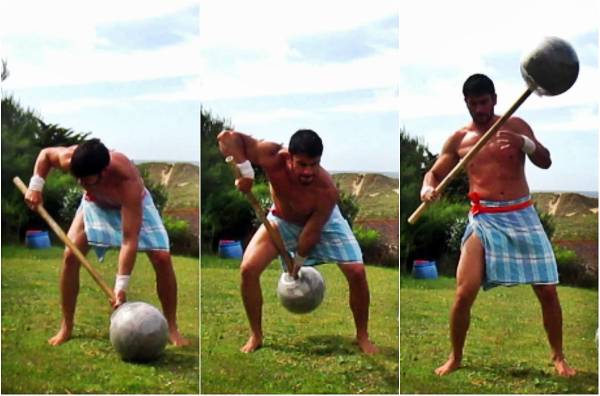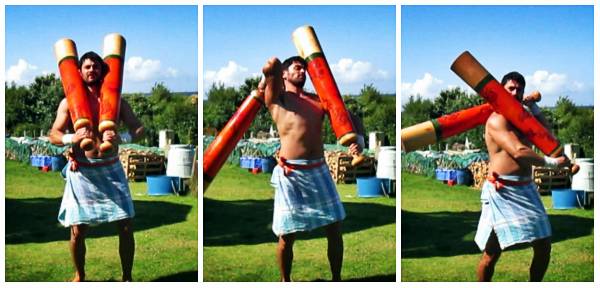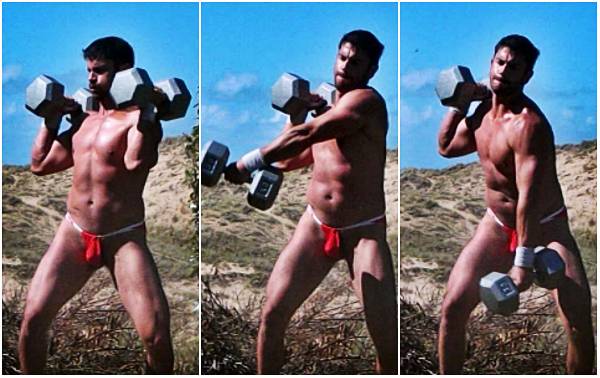During this and my next few articles, I will explain the incredible ancient exercises of the Kushti Wrestlers of Northern India and how to perform them. They are unique exercises, with far-reaching benefits for developing full-body strength and power.
The main exercises unique to the Indian wrestler’s training arsenal are:
During this and my next few articles, I will explain the incredible ancient exercises of the Kushti Wrestlers of Northern India and how to perform them. They are unique exercises, with far-reaching benefits for developing full-body strength and power.
The main exercises unique to the Indian wrestler’s training arsenal are:
- Gada (mace swing)
- Jori (club swing)
- Dumbbell swing
- Dand (often referred to as the Hindu push up)
- Bethak (often referred to as the Hindu squat)
Many other exercises are part of a wrestler’s program. Some are equally unique, such as the Sumtola (log-shaped Indian barbell) and Gar Nal (stone neck rings), while others are commonplace in gyms around the world, such as barbell and dumbbell exercises, and callisthenics, such as pull ups and dips.
True Minimalist Fitness
Regardless of the exercise, they are all used in a practical manner. Nothing is fancy or flamboyant.
Quite the opposite, the gymnasiums of Akhara are of pure minimalist design, with earthen floors, no fan or air conditioning units, rarely any mirrors, no sound systems.
If you are lucky, there is a water pump for your rehydration needs. The equipment is equally spartan, constructed from clay, stone, bamboo poles, wood, and iron. This is fitness stripped to its most bare and naked form.
Rarely will you hear screams for “One more rep!” or the clanking and clashing of heavy iron. Egos are left at the door, for the Akhara is also a temple to the Hindu god of strength, Hanuman.
This monkey deity has a shrine at each gymnasium, and before and after training the wrestlers will pay their respects by offering simple prayers. As such, each Akhara is by definition a holy place and is treated as such by all who enter.
The exercises listed here are what I would consider the core exercises of the Indian wrestlers’ workouts.
Not all are necessarily performed in a single workout by any single wrestler. They are generally dependent upon how the trainee feels or wants to accomplish, or dictated by what the Akhara guru (the chief of the gymnasium and usually an ex-wrestling champion) feels they should do.
Gada (Mace)
The Gada is a roughly constructed strength tool comprised of clay, cement, or stone with a bamboo pole over a meter long inserted into its center.
This gives it the appearance of a giant lollipop. The Gada was used as a weapon for many centuries in India. To increase a warrior’s battle prowess it was employed as a training tool. The main movement employed is the Rumali or Head Move.
- The Gada is swung from between the legs to gain momentum, then launched over the shoulder to begin the Rumali.
- Catching the momentum, the head of the Gada is then swung in in a pendulum arc behind the body before being pulled up and over the shoulder, pausing momentarily before being sent back over the opposite shoulder.
- The arcing movement is used again to achieve the same result on the opposite side. This is repeated for the desired number of repetitions.

The Gada is a great tool for developing grip, back, and shoulder power and if used correctly fully engages the core musculature. The Gada was the weapon of choice for Hanuman and in all depictions of him he is seen with this symbol of strength and power.
Jori (Clubs)
The Jori are clubs are always used as a pair, and again their heritage comes from warfare.
Many parallels have been drawn with Iranian clubs, or Meels, as the Persian invaded north India many centuries ago and thus there was an exchange of cultures. Today the Jori has its own separate identity. It takes great skill and coordination to wield Jori effectively, and it is an exhilarating experience once understood.

Again, the Jori move is called the Rumali (head move).
From the ready position, the Jori is swung over and away from the shoulder in a large semi-circular arc over one shoulder.
The Jori that is in motion is pulled cleanly over the shoulder to rest on the upper chest, the arm pulling it down and away. At the point of contact the second club will be swung, replicating the movement of the first.
The movement is done for repetitions. It is a particularly good exercise for the grip, shoulder girdle, back, chest, and torso.
It is a full-body exercise that requires timing and a high level of concentration. It also makes you feel like a true warrior!
Dumbbell Swing
The dumbbell swing evolved in the last couple of centuries when the British Empire ruled in India.
A cross-pollination of physical culture took place. The British saw values in the club training of the Indian wrestlers. The British modified it to suit their own needs and took it back to their country, where it widely became known as Indian club swinging. The modified version utilized smaller clubs in more of an intricate gymnastic fashion.
Meanwhile, the Indian wrestlers adopted the dumbbell to fit in with their current training paradigm.
The circular dumbbell swing, or cast, mirrors the Jori swing. Whereas the Jori is swung from the rear to the front, the dumbbells are swung from the front to the back. This makes them highly complementary to each other, in keeping with the holistic approach taken in Indian physical culture.
After cleaning a pair of dumbbells to the shoulder, rotate at the waist firing one bell across your center line in a semi-circular arc. Allow the weights momentum to carry through. Rotate your torso, using it as a counterweight.

Pull the dumbbell in quickly as it reaches the opposite side back to the clean position, dipping the knees to absorb the force. Repeat with the opposite dumbbell for repetitions.
This exercise is great for the grip and really hammers the upper back. It can get draining very quickly, especially when the weights are increased.
Programming Tips
To integrate these exercises into your own training, I would suggest initially using them at the beginning of your session to work on technique, or leaving them until the end for conditioning and grip.
- If you train at the start of your training session, spend 5-10 minutes playing around with one movement, seeing how it feels. Consider this as part of your warm up routine. Do not push it, but strive for perfect form.
- If you train at the end of your session, pick one exercise you have experience with and try to push yourself with it. A good examples would be 30 seconds of work, followed by 30 seconds of rest for a few minutes, using Tabata-style training, or performing a set number of repetitions on the minute for a set time.
Above all, have fun with these exercises! In my next article I will talk about the Dand and Bethak as well as how to create an all Indian exercise program. May the power be with you!
More Like This:
- The Ancient Sport of Longsword Fighting in the Modern World
- 4 Ancient Bodyweight Exercises for New Results
- 33 Reasons to Train Strongman






